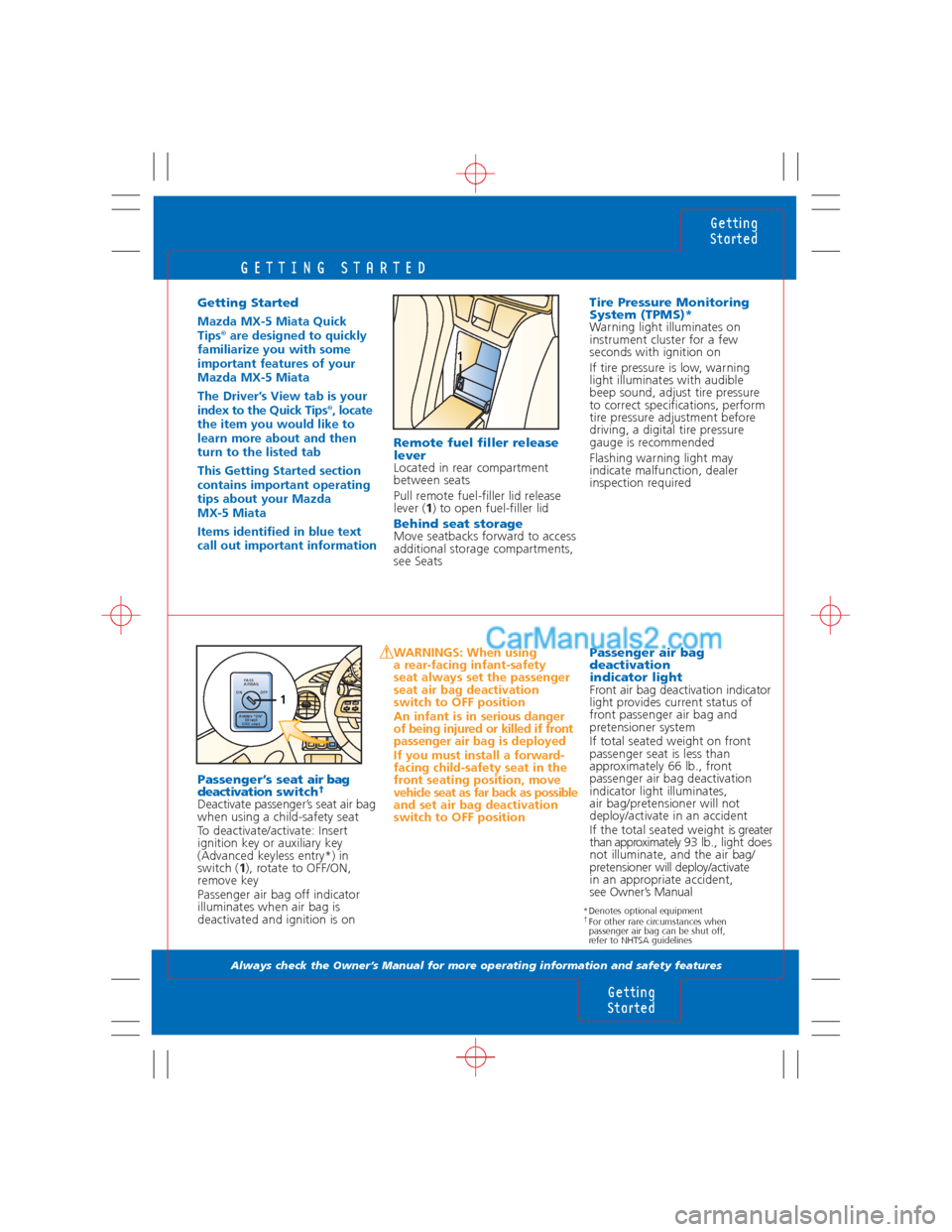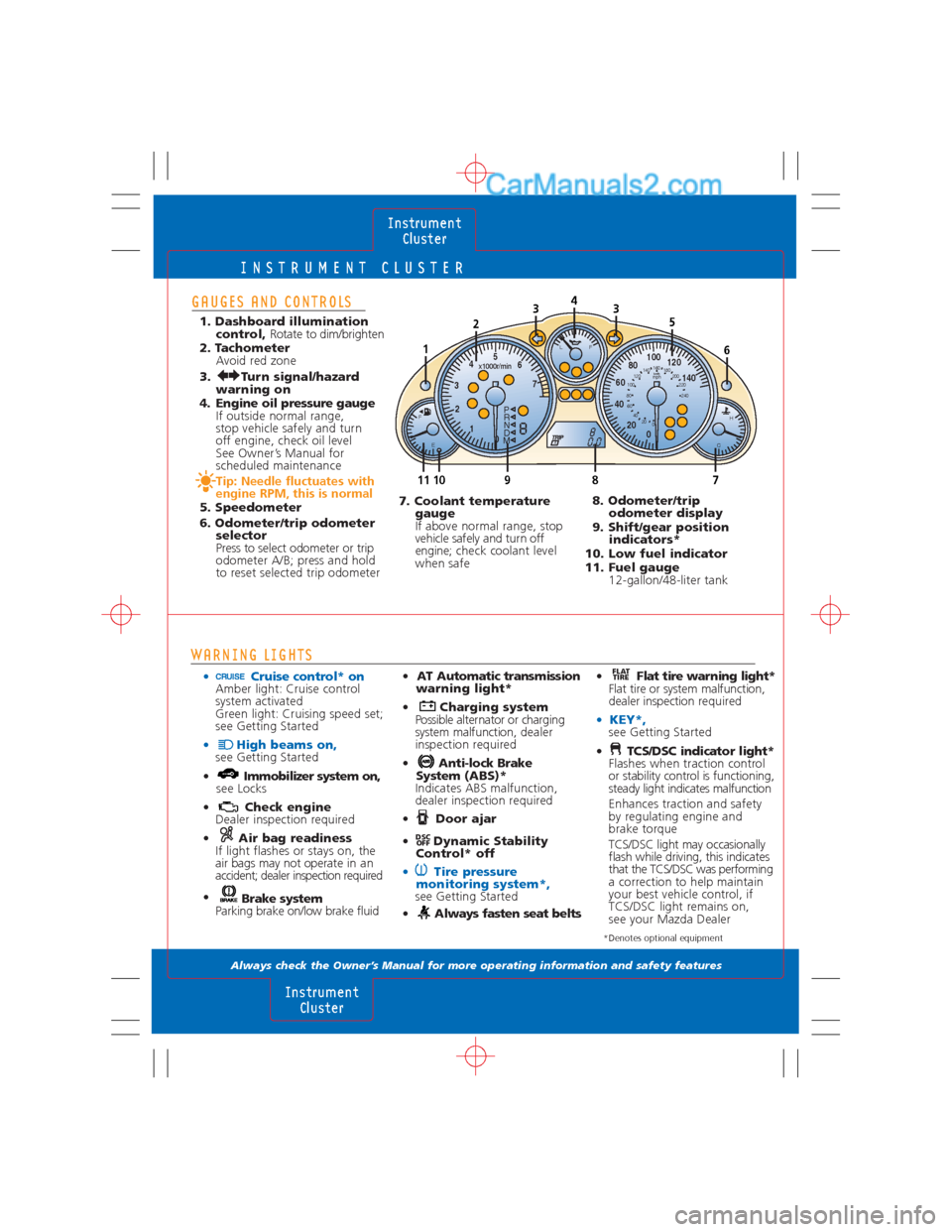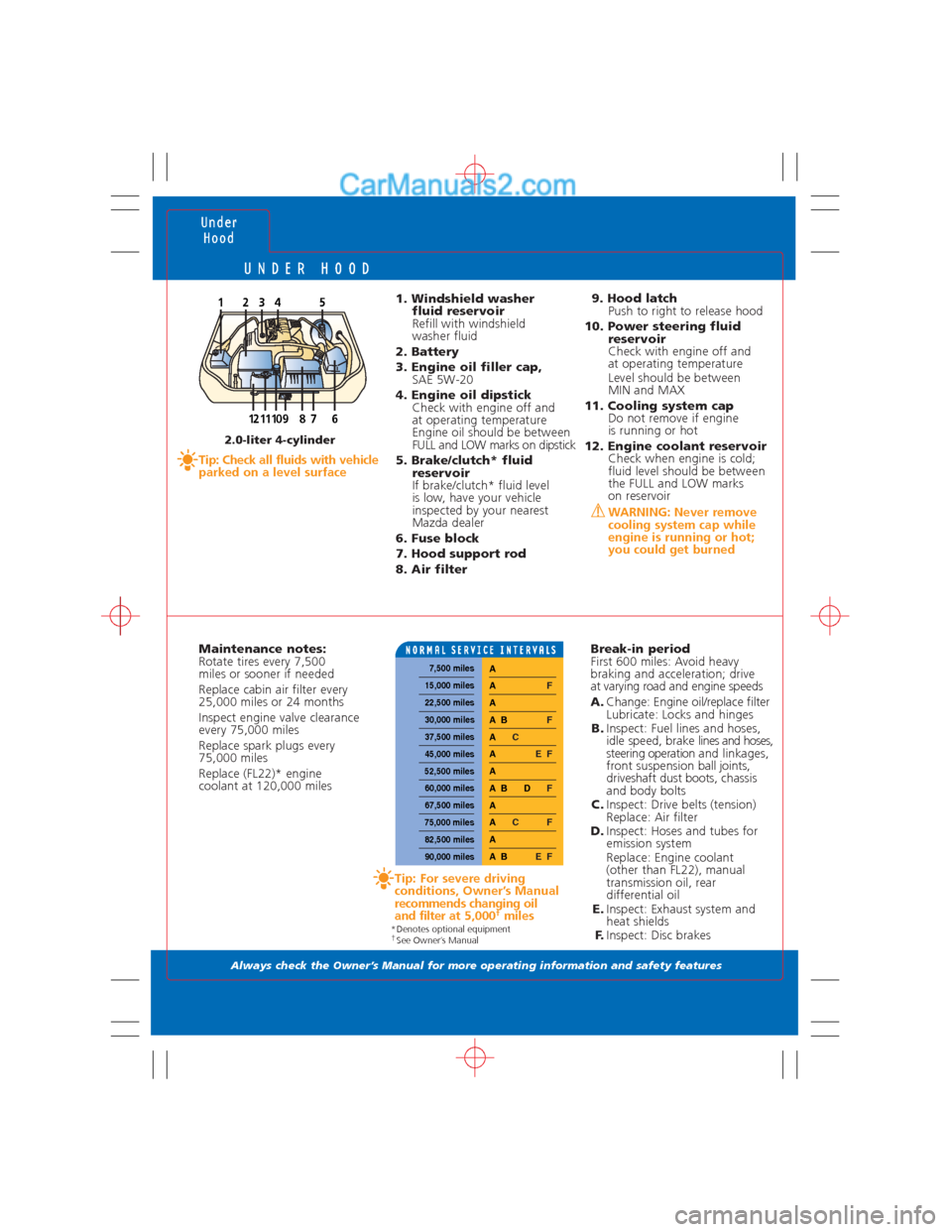fuel MAZDA MODEL MX-5 2006 Quick Tips (in English)
[x] Cancel search | Manufacturer: MAZDA, Model Year: 2006, Model line: MODEL MX-5, Model: MAZDA MODEL MX-5 2006Pages: 14, PDF Size: 1.62 MB
Page 3 of 14

GETTING STARTED
Always check the Owner’s Manual for more operating information and safety features
Getting Started
Mazda MX-5 Miata Quick
Tips
®are designed to quickly
familiarize you with some
important features of your
Mazda MX-5 Miata
The Driver’s View tab is your
index to the Quick Tips
®, locate
the item you would like to
learn more about and then
turn to the listed tab
This Getting Started section
contains important operating
tips about your Mazda
MX-5 Miata
Items identified in blue text
call out important informationTire Pressure Monitoring
System (TPMS)*
Warning light illuminates on
instrument cluster for a few
seconds with ignition on
If tire pressure is low, warning
light illuminates with audible
beep sound, adjust tire pressure
to correct specifications, perform
tire pressure adjustment before
driving, a digital tire pressure
gauge is recommended
Flashing warning light may
indicate malfunction, dealer
inspection required
WARNINGS: When using
a rear-facing infant-safety
seat always set the passenger
seat air bag deactivation
switch to OFF position
An infant is in serious danger
of being injured or killed if front
passenger air bag is deployed
If you must install a forward-
facing child-safety seat in the
front seating position, move
vehicle seat as far back as possible
and set air bag deactivation
switch to OFF positionPassenger air bag
deactivation
indicator light
Front air bag deactivation indicator
light provides current status of
front passenger air bag and
pretensioner system
If total seated weight on front
passenger seat is less than
approximately 66 lb., front
passenger air bag deactivation
indicator light illuminates,
air bag/pretensioner will not
deploy/activate in an accident
If the total seated weight is greater
than approximately 93 lb., light does
not illuminate, and the air bag/
pretensioner will deploy/activate
in an appropriate accident,
see Owner’s Manual
Getting
Started
Getting
Started
*Denotes optional equipment†For other rare circumstances when
passenger air bag can be shut off,
refer to NHTSA guidelines
Passenger’s seat air bag
deactivationswitch†
Deactivate passenger’s seat air bag
when using a child-safety seat
To deactivate/activate: Insert
ignition key or auxiliary key
(Advanced keyless entry*) in
switch (1), rotate to OFF/ON,
remove key
Passenger air bag off indicator
illuminates when air bag is
deactivated and ignition is on
Remote fuel filler release
lever
Located in rear compartment
between seats
Pull remote fuel-filler lid release
lever (1) to open fuel-filler lid
Behind seat storageMove seatbacks forward to access
additional storage compartments,
see Seats
1
E F2341
PA S S
AIRBAG
PA S S
AIRBAG
Always “ON”
Except
CRS used ON OFF
1
Page 6 of 14

INSTRUMENT CLUSTER
Always check the Owner’s Manual for more operating information and safety features
Instrument
Cluster
Instrument
Cluster
CHE F
LF
A0.08
781011
433
16x1000r/min
P
80 1 2 345
6
7
R
N
D
M
9
2
0 20 406080100
120
140
240 80
60
40
20
0220 100200 120180 140160
km/hmph
5
GAUGES AND CONTROLS
1. Dashboard illumination
control, Rotate to dim/brighten
2. Tachometer
Avoid red zone
3. Turn signal/hazard
warning on
4. Engine oil pressure gauge
If outside normal range,
stop vehicle safely and turn
off engine, check oil level
See Owner’s Manual for
scheduled maintenance
Tip: Needle fluctuates with
engine RPM, this is normal
5. Speedometer
6. Odometer/trip odometer
selector
Press to select odometer or trip
odometer A/B; press and hold
to reset selected trip odometer
• Cruise control* onAmber light: Cruise control
system activated
Green light: Cruising speed set;
see Getting Started
• High beams on,see Getting Started
• Immobilizer system on,
see Locks
• Check engine
Dealer inspection required
• Air bag readiness
If light flashes or stays on, the
air bags may not operate in an
accident; dealer inspection required
•
Brake system
Parking brake on/low brake fluid
• AT Automatic transmission
warning light*
• Charging system
Possible alternator or charging
system malfunction,dealer
inspection required
• Anti-lock Brake
System (ABS)*
Indicates ABS malfunction,
dealer inspection required
• Door ajar
• Dynamic Stability
Control* off
• Tire pressure
monitoring system*,
see Getting Started
• Always fasten seat belts
DSC
OFF
*Denotes optional equipment
WARNING LIGHTS
7. Coolant temperature
gauge
If above normal range, stop
vehicle safely and turn off
engine;check coolant level
when safe 8. Odometer/trip
odometer display
9. Shift/gear position
indicators*
10. Low fuel indicator
11. Fuel gauge
12-gallon/48-liter tank
• Flat tire warning light*
Flat tire or system malfunction,
dealer inspection required
• KEY*,see Getting Started
• TCS/DSC indicator light*
Flashes when traction control
or stability control is functioning,
steady light indicates malfunction
Enhances traction and safety
by regulating engine and
brake torque
TCS/DSC light may occasionally
flash while driving, this indicates
that the TCS/DSC was performing
a correction to help maintain
your best vehicle control, if
TCS/DSC light remains on,
see your Mazda Dealer
FLAT
TIRE
Page 14 of 14

UNDER HOOD
Always check the Owner’s Manual for more operating information and safety features
Under
Hood
Tip: Check all fluids with vehicle
parked on a level surface
1. Windshield washer
fluid reservoir
Refill with windshield
washer fluid
2. Battery
3. Engine oil filler cap,
SAE 5W-20
4. Engine oil dipstick
Check with engine off and
at operating temperature
Engine oil should be between
FULL and LOW marks on dipstick
5. Brake/clutch* fluid
reservoir
If brake/clutch* fluid level
is low, have your vehicle
inspected by your nearest
Mazda dealer
6. Fuse block
7. Hood support rod
8. Air filter9. Hood latch
Push to right to release hood
10. Power steering fluid
reservoir
Check with engine off and
at operating temperature
Level should be between
MIN and MAX
11. Cooling system cap
Do not remove if engine
is running or hot
12. Engine coolant reservoir
Check when engine is cold;
fluid level should be between
the FULL and LOW marks
on reservoir
WARNING: Never remove
cooling system cap while
engine is running or hot;
you could get burned
54312
9127118610
Maintenance notes:
Rotate tires every 7,500
miles or sooner if needed
Replace cabin air filter every
25,000 miles or 24 months
Inspect engine valve clearance
every 75,000 miles
Replace spark plugs every
75,000 miles
Replace (FL22)* engine
coolant at 120,000 miles
Tip: For severe driving
conditions, Owner’s Manual
recommends changing oil
and filter at 5,000
†miles
Break-in period
First 600 miles: Avoid heavy
braking and acceleration; drive
at varying road and engine speeds
A.Change: Engine oil/replace filter
Lubricate: Locks and hinges
B.Inspect: Fuel lines and hoses,
idle speed, brake lines and hoses,
steering operationand linkages,
front suspension ball joints,
driveshaft dust boots,chassis
and body bolts
C.Inspect: Drive belts (tension)
Replace: Air filter
D.Inspect: Hoses and tubes for
emission system
Replace: Engine coolant
(other than FL22), manual
transmission oil, rear
differential oil
E.Inspect: Exhaust system and
heat shields
F.Inspect: Disc brakes
2.0-liter 4-cylinder
7,500 miles
15,000 miles
22,500 miles
30,000 miles
37,500 miles
45,000 miles
52,500 miles
60,000 miles
67,500 miles
75,000 miles
82,500 miles
90,000 miles
A BE F
A A
C F
A A B D
F
A A
EF
A C
A BF
A
A
F
A
*Denotes optional equipment†See Owner’s Manual